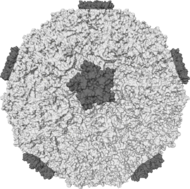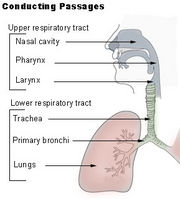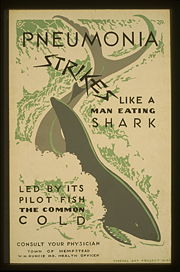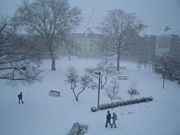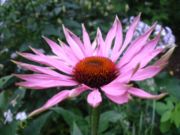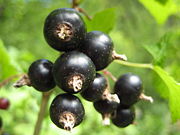Common cold
2008/9 Schools Wikipedia Selection. Related subjects: Health and medicine
| Acute nasopharyngitis Classification and external resources |
|
| Rhinoviruses cause most common colds | |
| ICD- 10 | J 00.0 |
| ICD- 9 | 460 |
| DiseasesDB | 31088 |
| MedlinePlus | 000678 |
| eMedicine | aaem/118 med/2339 |
| MeSH | D003139 |
Acute viral nasopharyngitis, or acute coryza, usually known as the common cold, is a highly contagious, viral infectious disease of the upper respiratory system, primarily caused by picornaviruses (including rhinoviruses) or coronaviruses.
Common symptoms are sore throat, runny nose, nasal congestion, sneezing and cough; sometimes accompanied by 'pink eye', muscle aches, fatigue, malaise, headaches, muscle weakness, and/or loss of appetite. Fever and extreme exhaustion are more usual in influenza. The symptoms of a cold usually resolve after about one week, but can last up to two. Symptoms may be more severe in infants and young children. Although the disease is generally mild and self-limiting, patients with common colds often seek professional medical help, use over-the-counter drugs, and may miss school or work days. The annual cumulative societal cost of the common cold in developed countries is considerable in terms of money spent on remedies, and hours of work lost.
The primary method to prevent infection is hand-washing to minimize person-to-person transmission of the virus. There are no antiviral drugs approved to treat or cure the infection. Most available medications are palliative and treat symptoms only. Megadoses of vitamin C, preparations from echinacea, and zinc gluconate have been studied as treatments for the common cold although none has been approved by the Food and Drug Administration or European Medicines Agency.
Pathology
Epidemiology
Upper respiratory tract infections are the most common infectious diseases among adults and teens, who have two to four respiratory infections annually. Children may have six to ten colds a year (and up to 12 colds a year for school children). In the United States, the incidence of colds is higher in the fall and winter, with most infections occurring between September and April. The seasonality may be due to the start of the school year, or due to people spending more time indoors (thus in closer proximity with each other) increasing the chance of transmission of the virus.
Virus
Common colds are most often caused by infection by one of the more than 100 serotypes of rhinovirus, a type of picornavirus. Other viruses causing colds are coronavirus, human parainfluenza viruses, human respiratory syncytial virus, adenoviruses, enteroviruses, or metapneumovirus. Due to the many different types of viruses, it is not possible to gain complete immunity to the common cold.
Transmission
The common cold virus is transmitted between people by one of two mechanisms:
- in aerosol form generated by coughing, sneezing.
- from contact with the saliva or nasal secretions of an infected person, either directly or from contaminated surfaces.
Symptoms are not necessary for viral shedding or transmission, as a percentage of asymptomatic subjects exhibit viruses in nasal swabs.
The virus enters the cells of the lining of the nasopharynx (the area between the nose and throat), and rapidly multiplies. The major entry point is normally the nose, but can also be the eyes (in this case drainage into the nasopharynx would occur through the nasolacrimal duct).
Symptoms
After initial infection, the viral replication cycle begins within 8 to 12 hours. Symptoms can occur shortly thereafter, and usually begin within 2 to 5 days after infection, although occasionally in as little as 10 hours after infection. The first indication of a cold is often a sore or scratchy throat. Other common symptoms are runny nose, congestion, sneezing and cough. These are sometimes accompanied by muscle aches, fatigue, malaise, headache, weakness, or loss of appetite. Colds occasionally cause fever and can sometimes lead to extreme exhaustion. (However, these symptoms are more usual in influenza, and can differentiate the two infections.) The symptoms of a cold usually resolve after about one week, but can last up to 14 days, with a cough lasting longer than other symptoms. Symptoms may be more severe in infants and young children, and may include fever and hives.
Complications
The common cold can lead to opportunistic coinfections or superinfections such as acute bronchitis, bronchiolitis, croup, pneumonia, sinusitis, otitis media, or strep throat. People with chronic lung diseases such as asthma and COPD are especially vulnerable. Colds may cause acute exacerbations of asthma, emphysema or chronic bronchitis.
Economic cost
USA
In the USA, the common cold leads to 75 to 100 million physician visits annually at a conservative cost estimate of $7.7 billion per year. Americans spend $2.9 billion on over-the-counter drugs and another $400 million on prescription medicines for symptomatic relief.
More than one-third of patients who saw a doctor received an antibiotic prescription, which not only contributes to unnecessary costs ($1.1 billion annually on an estimated 41 million antibiotic prescriptions in the United States), but also has implications for antibiotic resistance from overuse of such drugs.
An estimated 22 to 189 million school days are missed annually due to a cold. As a result, parents missed 126 million workdays to stay home to care for their children. When added to the 150 million workdays missed by employees suffering from a cold, the total economic impact of cold-related work loss exceeds $20 billion.
Prevention
The best way to avoid a cold is to avoid close contact with existing sufferers; to wash hands thoroughly and regularly; and to avoid touching the mouth and face. Anti-bacterial soaps have no effect on the cold virus; it is the mechanical action of hand washing with the soap that removes the virus particles.
In 2002, the Centers for Disease Control and Prevention recommended alcohol-based hand gels as an effective method for reducing infectious viruses on the hands of health care workers. As with hand washing with soap and water, alcohol gels provide no residual protection from re-infection.
The common cold is caused by a large variety of viruses, which mutate quite frequently during reproduction, resulting in constantly changing virus strains. Thus, successful immunization is highly improbable.
Exposure to cold weather
Although common colds are seasonal, with more occurring during winter, experiments so far have failed to produce evidence that short-term exposure to cold weather or direct chilling increases susceptibility to infection, implying that the seasonal variation is instead due to a change in behaviors such as increased time spent indoors at close proximity to others.
With respect to the causation of cold-like symptoms, researchers at the Common Cold Centre at the Cardiff University conducted a study to "test the hypothesis that acute cooling of the feet causes the onset of common cold symptoms." The study measured the subjects' self-reported cold symptoms, and belief they had a cold, but not whether an actual respiratory infection developed. It found that a significantly greater number of those subjects chilled developed cold symptoms 4 or 5 days after the chilling. It concludes that the onset of common cold symptoms can be caused by acute chilling of the feet. Some possible explanations were suggested for the symptoms, such as placebo, or constriction of blood vessels, however "further studies are needed to determine the relationship of symptom generation to any respiratory infection."
Treatment
As there is no medically proven and accepted medication directly targeting the causative agent, there is no cure for the common cold. Treatment is limited to symptomatic supportive options, maximizing the comfort of the patient, and limiting complications and harmful sequelae.
The common cold is self-limiting, and the host's immune system effectively deals with the infection. Within a few days, the body's humoral immune response begins producing specific antibodies that can prevent the virus from infecting cells. Additionally, as part of the cell-mediated immune response, leukocytes destroy the virus through phagocytosis and destroy infected cells to prevent further viral replication. In healthy, immunocompetent individuals, the common cold resolves in seven days on average.
Palliative care
The National Institute of Allergy and Infectious Diseases suggests getting plenty of rest, drinking fluids to maintain hydration, gargling with warm salt water, using cough drops, throat sprays, or over-the-counter pain or cold medicines. Saline nasal drops may help alleviate congestion.
The American Lung Association recommends avoiding coffee, tea or cola drinks that contain caffeine and avoiding alcoholic beverages, saying that both caffeine and alcohol cause dehydration. However, a study reported in 2000, as well as the U.S. Institute of Medicine in 2004, say that caffeinated beverages and non-caffeinated beverages equally meet the need for fluids.
Antibiotics
Antibiotics, targeted primarily to microorganisms like bacteria and fungus, do not have any beneficial effect against the common cold. Their use in cases of common cold infection is ineffective as they have no effect on viruses.
Antivirals
There are no approved antiviral drugs for the common cold.
ViroPharma and Schering-Plough are developing an antiviral drug, pleconaril, that targets picornaviruses, the viruses that cause the majority of common colds. Pleconaril has been shown to be effective in an oral form. Schering-Plough is developing an intra-nasal formulation that may have fewer adverse effects.
Over-the-counter symptom medicines
There are a number of effective treatments which, rather than treat the viral infection, focus on relieving the symptoms. For some people, colds are relatively minor inconveniences and they can go on with their daily activities with tolerable discomfort. This discomfort has to be weighed against the price and possible side effects of the remedies.
- analgesics such as aspirin or paracetamol (acetaminophen), as well as localised versions targeting the throat (often delivered in lozenge form)
- nasal decongestants such as pseudoephedrine or oxymetazoline which reduce the inflammation in the nasal passages by constricting dilated local blood vessels
- cough suppressants such as dextromethorphan which suppress the cough reflex.
- first-generation anti-histamines such as brompheniramine, chlorpheniramine, diphenhydramine and clemastine (which reduce mucus gland secretion and thus combat blocked/runny noses but also may make the user drowsy). Second-generation anti-histamines do not have a useful effect on colds.
Herbal remedies
| Chamomile | Liquorice | Garlic | Ginger |
|---|---|---|---|
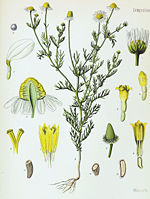 |
 |
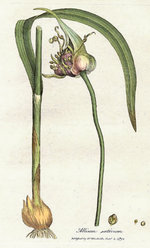 |
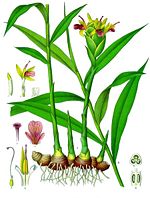 |
Herbal teas, such as chamomile tea, or lemon or ginger root tisanes may soothe some symptoms and comfort the patient. Liquorice and garlic preparations have been suggested as treatments for the common cold, although their effectiveness is unproven.
Echinacea
Echinacea, commonly called coneflowers, is a plant commonly used in herbal preparations for the treatment of the common cold.
Although there have been scientific studies evaluating echinacea, its effectiveness has not been convincingly demonstrated. For example, a peer-reviewed clinical study published in the New England Journal of Medicine concluded that "…extracts of E. angustifolia root, either alone or in combination, do not have clinically significant effects on rhinovirus infection or on the clinical illness that results from it." Recent randomized, double-blind, placebo-controlled studies in adults have not shown a beneficial effect of echinacea on symptom severity or duration of the cold. A structured review of 9 placebo controlled studies suggested that the effectiveness of echinacea in the treatment of colds has not been established. Conversely, two recent meta-analyses of published medical articles concluded that there is some evidence that echinacea may reduce either the duration or severity of the common cold, but results are not fully consistent. However, there have been no large, randomized placebo-controlled clinical studies that definitively demonstrate either prophylaxis or therapeutic effects in adults. A randomized, double-blind, placebo-controlled study in 407 children of ages ranging from 2 to 11 years showed that echinacea did not reduce the duration of the cold, nor reduce the severity of the symptoms. Most authoritative sources consider the effect of echinacea on the cold unproven.
Other
Vitamin C
A well-known supporter of the theory that Vitamin C megadosage prevented infection was Nobel Prize winner Linus Pauling, who wrote the bestseller Vitamin C and the Common Cold. A meta-analysis published in 2005 found that "the lack of effect of prophylactic vitamin C supplementation on the incidence of common cold in normal populations throws doubt on the utility of this wide practice".
A follow-up meta-analysis supported these conclusions:
Prophylactic use "...of vitamin C has no effect on common cold incidence ... [but] reduces the duration and severity of common cold symptoms slightly, although the magnitude of the effect was so small its clinical usefulness is doubtful. Therapeutic trials of high doses of vitamin C ... starting after the onset of symptoms, showed no consistent effect on either duration or severity of symptoms. ... More therapeutic trials are necessary to settle the question, especially in children who have not entered these trials."
Most of the studies showing little or no effect employ doses of ascorbate such as 100 mg to 500 mg per day, considered "small" by vitamin C advocates. Equally important, the plasma half life of high dose ascorbate above the baseline, controlled by renal resorption, is approximately 30 minutes, which implies that most high dose studies have been methodologically defective and would be expected to show a minimum benefit. Clinical studies of divided dose supplementation, predicted on pharmacological grounds to be effective, have only rarely been reported in the literature.
Zinc preparations
Zinc acetate and zinc gluconate have been tested as potential treatments for the common cold, in various dosage form including nasal sprays, nasal gels, and lozenges. Some studies have shown some effect of zinc preparations on the duration of the common cold, but conclusions are diverse. About half of studies demonstrate efficacy. Even studies that show clinical effect have not demonstrated the mechanism of action. The studies differ in the salt used, concentration of the salt, dosage form, and formulation, and some suffer from defects in design or methods. For example, there is evidence that the potential efficacy of zinc gluconate lozenges may be affected by other food acids ( citric acid, ascorbic acid and glycine) present in the lozenge. Furthermore, interpretation of the results depends on whether concentration of total zinc or ionic zinc is considered.
There are concerns regarding the safety of long-term use of cold preparations in an estimated 25 million persons who are haemochromatosis heterozygotes. Use of high doses of zinc for more than two weeks may cause copper depletion, which leads to anaemia. Other adverse events of high doses of zinc include nausea, vomiting gastrointestinal discomfort, headache, drowsiness, unpleasant taste, taste distortion, abdominal cramping, and diarrhea. Some users of nasal spray applicators containing zinc have reported temporary or permanent loss of sense of smell.
Although widely available and advertised in the United States as dietary supplements or homeopathic treatments, the safety and efficacy of zinc preparations have not been evaluated or approved by the Food and Drug Administration. Authoritative sources consider the effect of zinc preparations on the cold unproven.
A recent study showed that zinc acetate lozenges (13.3 mg zinc) shortened the duration and reduced the severity of common colds compared to placebo in a placebo-controlled, double blind clinical trial. Intracellular Adhesion Molecule-1 (ICAM-1) was inhibited by the ionic zinc present in the active lozenges, and the difference was statistically significant between the groups.
Steam inhalation
Many people believe that steam inhalation reduces symptoms of the cold.
However, a double-blind, placebo-controlled, randomized study found no effect of steam inhalation on cold symptoms. A scientific review of medical literature concluded that "there is insufficient evidence to support the use of steam inhalation as a treatment." There have been reports of children being badly burned when using steam inhalation to alleviate cold symptoms leading to the recommendation to "...start discouraging patients from using this form of home remedy, as there appears to be no significant benefit from steam inhalation."
Chicken soup
In the twelfth century, Moses Maimonides wrote, " Chicken soup...is recommended as an excellent food as well as medication." Since then, there have been numerous reports in the United States that chicken soup alleviates the symptoms of the common cold. Even usually staid medical journals have published tongue-in-cheek humorous articles on the alleged medicinal properties of chicken soup.
Historical research
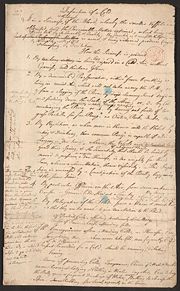
The name "common cold" came into use in the 16th century, due to the similarity between its symptoms and those of exposure to cold weather. Norman Moore relates in his history of the Study of Medicine that James I continually suffered from nasal colds, which were then thought to be caused by polypi, sinus trouble, or autotoxaemia.
In the 18th century, Benjamin Franklin considered the causes and prevention of the common cold. After several years of research he concluded: "People often catch cold from one another when shut up together in small close rooms, coaches, etc. and when sitting near and conversing so as to breathe in each other's transpiration." Although viruses had not yet been discovered, Franklin hypothesized that the common cold was passed between people through the air. He recommended exercise, bathing, and moderation in food and drink consumption to avoid the common cold. Franklin's theory on the transmission of the cold was confirmed some 150 years later.
Common Cold Unit
In the United Kingdom, the Common Cold Unit was set up by the Medical Research Council in 1946. The unit worked with volunteers who were infected with various viruses. The rhinovirus was discovered there. In the late 1950s, researchers were able to grow one of these cold viruses in a tissue culture, as it would not grow in fertilized chicken eggs, the method used for many other viruses. In the 1970s, the CCU demonstrated that treatment with interferon during the incubation phase of rhinovirus infection protects somewhat against the disease, but no practical treatment could be developed. The unit was closed in 1989, two years after it completed research of zinc gluconate lozenges in the prophylaxis and treatment of rhinovirus colds, the only successful treatment in the history of the unit.
